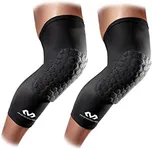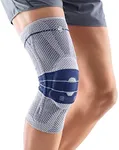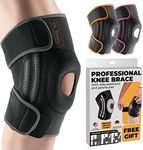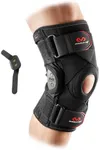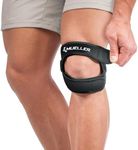Buying Guide for the Best Knee Supporters
Choosing the right knee supporter is crucial for providing the necessary support and protection to your knee, whether you're recovering from an injury, looking to prevent one, or seeking extra stability during physical activities. The right knee supporter can help alleviate pain, improve mobility, and enhance your overall performance. To make an informed decision, it's important to understand the key specifications and how they relate to your specific needs.Type of Knee SupporterThere are several types of knee supporters, including sleeves, straps, braces, and wraps. Sleeves provide compression and are ideal for mild support and pain relief. Straps are useful for targeting specific areas, such as patellar tendinitis. Braces offer more rigid support and are suitable for more severe injuries or post-surgery recovery. Wraps allow for adjustable compression and support. Choose the type based on the level of support you need and the specific condition you're addressing.
MaterialKnee supporters are made from various materials like neoprene, spandex, nylon, and cotton. Neoprene is popular for its durability and excellent compression, but it can be less breathable. Spandex and nylon offer a good balance of support and breathability, making them suitable for extended wear. Cotton is comfortable and breathable but may not provide as much support. Consider your comfort, the duration of wear, and any potential allergies when selecting the material.
Size and FitA proper fit is essential for the effectiveness of a knee supporter. Sizes typically range from small to extra-large, and some models offer adjustable straps for a customized fit. Measure the circumference of your knee or thigh as instructed by the manufacturer to find the right size. A supporter that is too tight can restrict blood flow, while one that is too loose may not provide adequate support. Ensure the supporter fits snugly but comfortably.
Level of SupportKnee supporters offer varying levels of support, from mild to maximum. Mild support is suitable for minor aches, pains, and general prevention. Moderate support is ideal for more significant pain, mild injuries, or post-surgery recovery. Maximum support is necessary for severe injuries, chronic conditions, or high-impact activities. Assess your condition and activity level to determine the appropriate level of support you need.
Mobility and FlexibilityThe design of the knee supporter can affect your range of motion. Some supporters are more rigid and may limit movement, which is beneficial for severe injuries requiring stabilization. Others are more flexible, allowing for greater mobility, which is ideal for sports and daily activities. Consider your activity level and the balance between support and mobility you need when choosing a knee supporter.
Breathability and Moisture-WickingBreathability and moisture-wicking properties are important for comfort, especially during prolonged use or physical activities. Supporters with breathable materials and moisture-wicking technology help keep your skin dry and reduce the risk of irritation. If you plan to wear the supporter for extended periods or during exercise, prioritize these features to maintain comfort.
Ease of UseSome knee supporters are easier to put on and take off than others. Sleeves and wraps are generally straightforward, while braces with multiple straps and adjustments may require more effort. Consider how often you'll need to wear and remove the supporter and choose one that fits your lifestyle and convenience needs.
